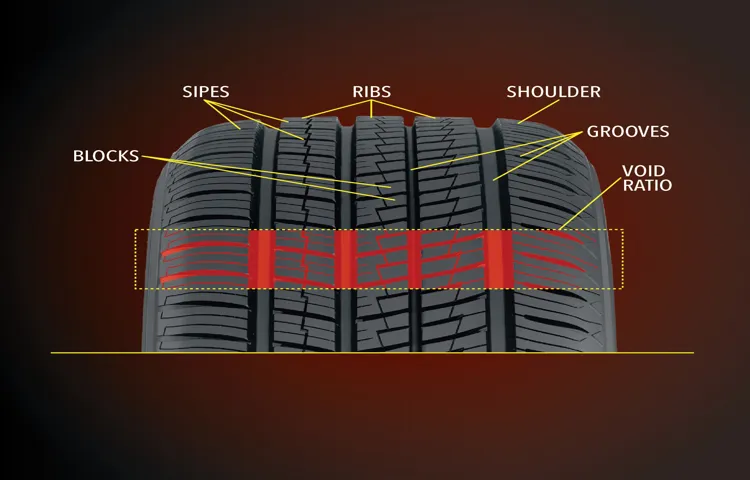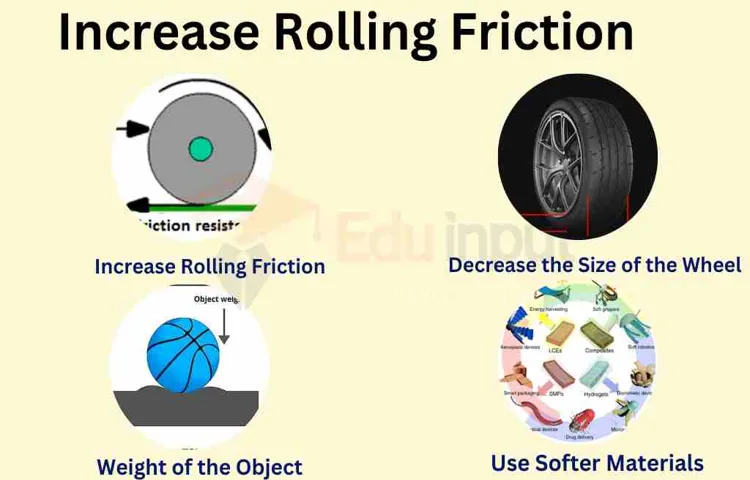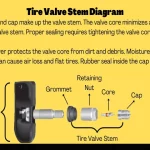Looking at the design of a tire, one might assume that the primary function of the tread is to provide traction with the road. And while that is certainly true, there’s more to it than that. In fact, the way in which tire treads interact with the road can impact the vehicle’s handling, braking ability, and even fuel efficiency.
The grooves in a tire’s tread pattern serve to increase or decrease friction between the tire and the road. How do they do this? Let’s take a closer look.
Table of Contents
What Are Tire Treads and Why Are They Important?
Tire treads are the patterns on the surface of a tire that are in contact with the road. These treads serve a crucial role in maintaining a vehicle’s stability and preventing accidents. The best way to understand how tire treads work is to envision it as gripping onto the road.
This increased friction caused by the grip is what prevents the car from skidding or sliding on slippery roads. Tire treads are designed to channel water and slush away from the tire’s surface, which reduces the risk of hydroplaning and improves vehicle control in wet conditions. The depth and spacing of tire treads can determine a vehicle’s handling, depending on whether the treads are closer or farther apart.
The more traction a tire has, the better it performs in different weather and road conditions. Hence, it’s crucial to monitor your tire treads’ health and replace them when necessary to ensure your safety and that of other road users.
Definition of tire treads
Tire treads are the grooves on the surface of a tire that come in contact with the road. They’re designed to provide grip and traction while driving, especially during wet or snowy conditions. These treads help displace water or snow from under the tire, reducing the likelihood of hydroplaning or slipping.
Tire treads are crucial for safety while driving, as they provide stability and control, preventing accidents caused by skidding. They also affect fuel efficiency, as worn-out treads can reduce gas mileage and increase the chances of tire blowouts. It’s important to regularly monitor your tire treads and replace them when they become too worn or damaged.
This will ensure that your tires perform optimally and keep you safe on the road.

Importance of tire treads for traction and safety
Tire treads are the grooves on the surface of a tire that help provide traction and safety while driving. The purpose of tire treads is to channel water and other debris away from the contact patch, allowing the tire to maintain a good grip on the road surface. Without proper tread, tires may be more prone to hydroplaning and losing traction, especially in wet or snowy conditions.
Tread depth is an important factor to consider when assessing a tire’s safety and performance. Worn down or bald tires can greatly reduce a vehicle’s ability to stop or turn quickly, putting the driver and passengers at risk. Regular tire maintenance and inspections can help ensure that tire treads are in good condition, providing maximum traction and safety while driving.
So, it is crucial to pay attention to tire treads and replace them if necessary to avoid any unwanted accidents.
How Do Tire Treads Increase Friction?
Have you ever wondered how tire treads work to increase or decrease friction? Well, let me explain. Tire treads are designed to displace water, dirt, and other debris, allowing the tire to maintain contact with the road surface. The deeper the tread, the more water and debris it can displace, improving traction and decreasing the likelihood of hydroplaning or slipping on wet or slippery surfaces.
Additionally, treads can create small spaces between the tire and the road, increasing interlocking friction and preventing slipping or skidding in adverse conditions. Different types of tread patterns can also affect a tire’s performance. For example, aggressive treads with larger blocks and deeper channels are better for off-road driving, while smoother treads are better for highway driving.
Overall, tire treads are a crucial component of a tire’s design, providing the necessary grip and traction to keep you safe on the road.
Contact with road surface
Tire treads play a crucial role in increasing friction between the tires and the road surface. The pattern of the treads on the rubber surface helps to channel water, dirt, and debris away from the tire, ensuring that the tire maintains contact with the road. The deeper and wider the treads, the better the traction, especially on wet or slippery road conditions.
When the tire rotates, the treads compress and grip the road surface, creating friction that makes it easier for the vehicle to move forward. This is why tire treads are especially important for safe driving and why it is necessary to replace your tires once they become worn down. Ultimately, having good tread depth helps your tires keep their grip, helping you to maintain control and stay safe while driving.
So, the next time you think about tire treads, remember that they are helping to increase your friction and keeping you safe on the road!
Skid resistance
When it comes to skid resistance, tire treads play a crucial role in increasing friction and providing better traction on the road. Tire treads are designed with patterns of grooves and channels that are strategically placed to displace water and debris from the surface of the tire. This ensures that the tire maintains contact with the road surface, even in wet or slippery conditions.
The depth and width of the tire treads also help to increase the surface area of the tire in contact with the road, which further enhances grip and traction. This is why tires with deeper treads are often recommended for driving on wet or snowy roads. Additionally, the material used in tire treads is engineered to provide a certain level of grip and durability, ensuring that the tire maintains its traction and skid resistance over time.
So, the next time you hit the road, remember that your tire treads play an important role in keeping you safe and steady on the road.
Grip and braking performance
Tire treads are an essential component in increasing the friction of a tire and improving grip and braking performance. The design of the tire tread pattern plays a crucial role in how it interacts with the road surface. The grooves and channels in the tread allow water, snow, or mud to be pushed outwards, which ultimately improves traction between the tire and the road.
The wider the grooves, the more efficiently a tread can clear water. The depth of the tread also impacts grip by providing additional surface area for the tire to grip on the road. Moreover, the angle of the grooves influences how the tire deforms when it contacts the road surface.
This can have a significant impact on handling and braking. Tire treads promote better friction and ultimately increase the tire’s grip, thereby improving overall driving safety and performance.
How Do Tire Treads Decrease Friction?
Have you ever wondered how tire treads work to increase or decrease friction? Well, let me tell you. Tire treads are designed in a way to create channels for water to flow through. The grooves in the treads help to push water away from the tire, which prevents hydroplaning or skidding.
This is especially important in wet or icy conditions where the roads are slippery. The rubber in the tire treads also helps to increase friction by gripping the road surface. When you press on the accelerator, the treads create a force against the road that propels the car forward.
On the other hand, when you apply the brakes, the treads provide the necessary friction to slow down or stop the car. So, the next time you take a drive, remember that those tire treads are more than just a design element – they play a critical role in keeping you safe on the road.
Hydroplaning and aquaplaning risks
Tire treads play a crucial role in reducing the risk of hydroplaning or aquaplaning while driving on wet roads. Hydroplaning occurs when the tires lose contact with the road surface due to a layer of water between the tires and the pavement. This can result in a complete loss of vehicle control, causing accidents and damage.
Tire treads help to decrease friction by channeling the water away from the tire, allowing it to maintain contact with the road. The pattern of the tread and the depth of the grooves are specifically designed to prevent hydroplaning and provide better traction on wet surfaces. This is why it is important to regularly check the tread depth and replace worn-out tires.
Properly inflated tires also help to maintain better contact with the road surface, thereby reducing the risk of hydroplaning. Remember, better tire traction equals better control on the roads, especially during adverse weather conditions.
Tire tread wear and reduced effectiveness
Tire tread wear can lead to reduced effectiveness, which can be a dangerous situation for drivers. The reason why tire treads decrease friction is due to the loss of contact patch between the tire and the road surface. The more worn the tire tread, the less grip and handling a vehicle will have on the road.
This happens because the tire tread is responsible for channeling water and debris away from the tire, which helps to maintain maximum contact with the road surface. The deeper the tire tread, the better it is at pushing away water and debris. When the tire tread wears down, the channels become shallower, meaning less water and debris can be directed away from the tire.
As a result, the tire begins to lose traction and become less effective at stopping, turning, and accelerating. This can increase the chance of losing control and sliding, especially in wet or slippery conditions. To avoid this situation, it is important to regularly check tire tread depth and replace tires before they become too worn.
Maintaining Proper Tire Tread for Optimal Friction
Tire treads play a crucial role in maintaining optimal friction between the tires and the road surface. The design, depth, and width of tire treads impact the way the tires grip the road, affecting the vehicle’s handling, stability, and safety. When the tire treads are new, they offer greater friction by providing increased contact between the tires and the road surface, which enhances the vehicle’s ability to accelerate, brake, and turn.
However, as the tires wear, the tread depth reduces, leading to reduced friction, which can cause skidding, hydroplaning, or loss of control. Therefore, it’s essential to monitor the tire treads and replace the tires when they reach the minimum tread depth. By doing so, you can ensure that the tires provide optimal friction and maintain the safety of the vehicle and the passengers.
So, keep an eye on your tire treads and be proactive about replacing them to ensure maximum friction and control on the road.
Tire maintenance, rotation, and replacement tips
Tire maintenance is crucial for any vehicle owner, and one of the most important aspects of tire care is ensuring that the tread is in good condition. Proper tire tread is essential for optimal friction between the tire and the road, which keeps you and your passengers safe. One way to monitor your tire tread is by using a penny: insert the penny into the tread grooves with Lincoln’s head upside down.
If you can see all of Lincoln’s head, then your tread is too low and it’s time for replacement. Regular rotation of your tires can also help prevent uneven wear and extend the life of your tires. It’s recommended to rotate your tires every 6,000-8,000 miles.
When it’s time to replace your tires, be sure to choose ones that are suited for your vehicle and driving needs. Don’t skimp on quality; investing in high-quality tires is an investment in your safety. Overall, maintaining proper tire tread is an essential aspect of tire care that every vehicle owner should prioritize.
Conclusion
In conclusion, tire treads are like the shoes of a car that grip the road and provide traction. They work by increasing the surface area of the tire in contact with the road, which in turn increases friction and improves grip. The patterns and depth of the treads also play a vital role in determining the tire’s performance in different weather and road conditions.
So next time you hit the road, remember that it’s the tire treads that keep you grounded and make every ride a smooth one!”
FAQs
What is the purpose of tire treads?
The purpose of tire treads is to increase traction and decrease the risk of hydroplaning.
How do tire treads improve traction?
Tire treads improve traction by creating multiple contact points with the road surface, increasing friction and grip.
What happens if tire treads wear down?
If tire treads wear down, the tire loses its ability to provide traction, increasing the risk of skidding or sliding.
How deep do tire treads need to be to provide proper traction?
Tire treads need to be at least 2/32 of an inch deep to provide proper traction.
Can different types of tire treads affect performance?
Yes, different types of tire treads can affect performance. For example, aggressive treads are better for off-road driving while smooth treads are better for highway driving.
How do tire treads affect fuel efficiency?
Tire treads can affect fuel efficiency in a negative way. Deep treads can increase rolling resistance and decrease fuel economy.
How can I maintain my tire treads?
You can maintain your tire treads by regularly checking their depth and ensuring they are properly inflated. Also, avoid overloading your vehicle to prevent excess wear on the tires.



